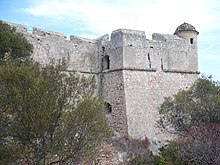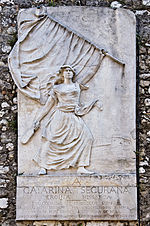Siege of Nice
[5] In the Mediterranean, active naval collaboration took place between France and the Ottoman Empire to fight against Spanish forces, following a request by Francis I, conveyed by Antoine Escalin des Aimars.
[8] Following an agreement between Francis I and Suleyman the Magnificent, through the intervention of the French ambassador in Constantinople, Captain Polin, a fleet of 110 galleys under Hayreddin Barbarossa left from the Sea of Marmara in mid-May 1543.
[21] He nevertheless displayed great reluctance to attack Andrea Doria when the latter was put in difficulty after landing the relief army, losing 4 galleys in a storm.
[9] Following the siege, the Ottomans were offered by Francis to winter at Toulon, so that they could continue to harass the Holy Roman Empire, and especially the coast of Spain and Italy, as well the communications between the two countries.
[9] Throughout the winter, the Ottoman fleet, with its 110 galleys and 30,000 troops, was able to use Toulon as a base to attack the Spanish and Italian coasts under Admiral Salah Rais.
[9][22] They raided Barcelona in Spain, and Sanremo, Borghetto Santo Spirito, Ceriale in Italy, and defeated Italo-Spanish naval attacks.
[23] France provided about 10,000,000 kilograms of bread to supply the Ottoman army during the 6 months it stayed in Toulon, and for the provisioning of the following summer's campaign and return to Constantinople.
Catherine's existence has never been definitively proven, and her heroic act of mooning is likely pure fiction or highly exaggerated; Jean Badat, a historian who stood witness to the siege, made no mention of her involvement in the defense.
Historically attested defense of Nice include the townspeople's destruction of a key bridge and the arrival of an army mustered by a Savoyard duke, Charles III.





